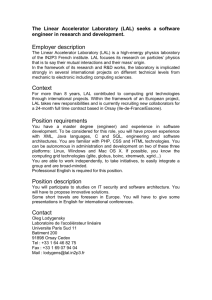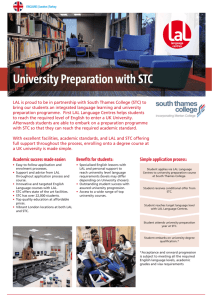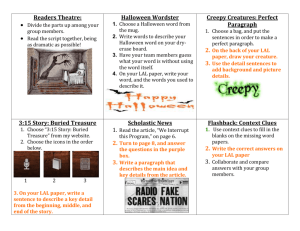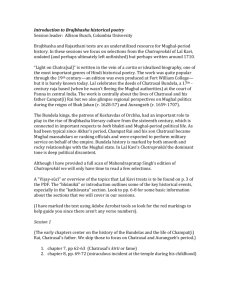Document 13047132
advertisement
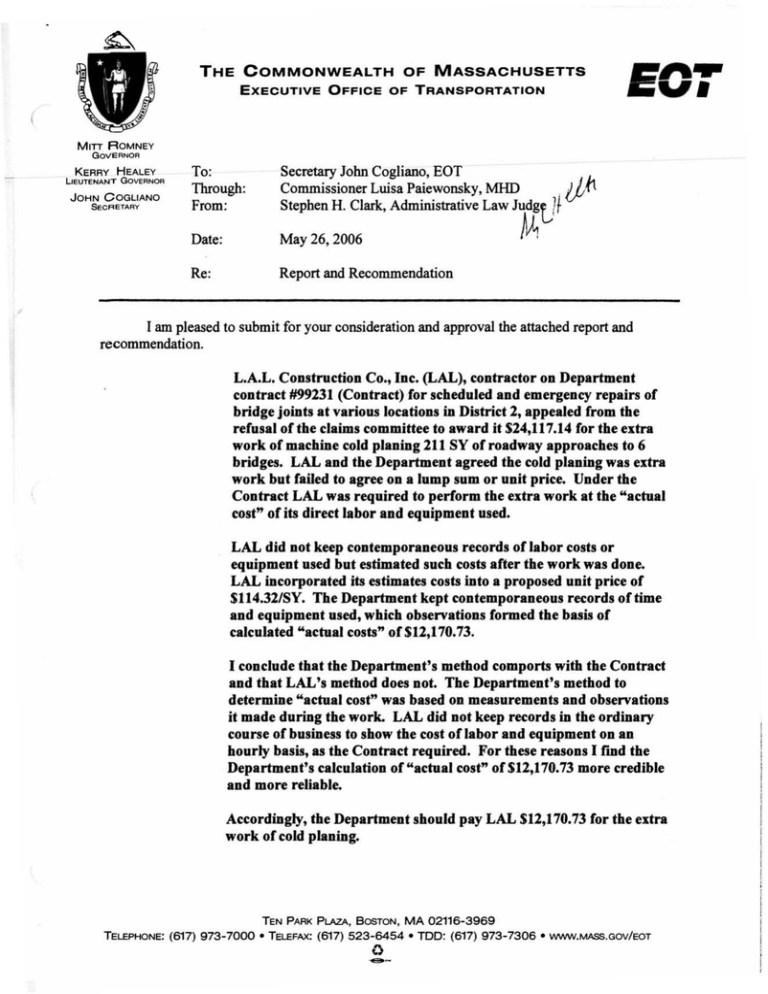
THE COMMONWEALTH OF MASSACHUSETTS EXECUTIVE OFFICE OF TRANSPORTATION MITT ROMNEY GOVERNOR KERRY HEALEY LIeUTENANT GOVERNOR JOHN COGLIANO S e CRETARY To: Through: From: Secretary John Cogliano, EOT Commissioner Luisa Paiewonsky, MHD Stephen H. Clark, Administrative Law Judgf}f Date: May 26, 2006 Re: Report and Recommendation .lJft M I I am pleased to submit for your consideration and approval the attached report and recommendation. L.A.L. Construction Co., Inc. (LAL), contractor on Department contract #99231 (Contract) for scheduled and emergency repairs of bridge joints at various locations in District 2, appealed from the refusal of the claims committee to award it $24,117.14 for the extra work of machine cold planing 211 SY of roadway approaches to 6 bridges. LAL and the Department agreed the cold planing was extra work but failed to agree on a lump sum or unit price. Under the Contract LAL was required to perform the extra work at the "actual cost" of its direct labor and equipment used. LAL did not keep contemporaneous records of labor costs or equipment used but estimated such costs after the work was done. LAL incorporated its estimates costs into a proposed unit price of $114.32/SY. The Department kept contemporaneous records of time and equipment used, which observations formed the basis of calculated "actual costs" of $12,170.73. I conclude that the Department's method comports with the Contract and that LAL's method does not. The Department's method to determine "actual cost" was based on measurements and observations it made during the work. LAL did not keep records in the ordinary course of business to show the cost of labor and equipment on an hourly basis, as the Contract required. For these reasons I f"md the Department's calculation of "actual cost" of $12,170.73 more credible and more reliable. Accordingly, the Department should pay LAL $12,170.73 for the extra work of cold planing. TELEPHONE: TEN PARK PLAZA, BOSTON , MA 02116-3969 (617) 973-7000 • TELEFAX: (617) 523-6454 • TOO: (617) 973-7306 • I/IN'NII.MASS.Gov/EOT o .- ­ INTRODUCTION L.A.L. Construction Co., Inc. (LAL), the general contractor on Department contract #99231 (Contract) for “scheduled and emergency repairs of bridge joints at various locations in District 2,” appeals from the denial of the claims committee’s determination of the “actual costs” to perform extra work of cold planning on the roadway approaches. Because the Department and LAL did not agree on a lump sum or unit price before LAL began, Subsection 9.03 of the Standard Specifications required the Department to pay LAL the “actual cost” for the extra work. It is undisputed that LAL cold planed 211 square yards (SY) of old pavement on the roadway approaches to six bridges. 1 This appeal must decide LAL’s “actual cost” under Subsection 9.03. LAL claims the Department should pay it $24,117.14 based on its own estimates made after the fact of labor expended and equipment used. It argues that the Department must insert Item 129.0 (“Bituminous Concrete Excavation By Cold Planer”) (Item 129) of the Standard Specifications into the Contract and pay LAL as if the extra work were done under Item 129. The Department argues, and the claims committee agreed, that the Department should pay LAL $12,170.73 based on records of labor and equipment kept at the time. LAL’s appeal has no merit. The Contract provides that LAL “accept as full payment” the “actual cost” to perform the extra work. The Department was not required to add a pay item to the Contract. LAL did not keep contemporaneous records of its actual labor and equipment costs. Because it did not keep such records, LAL could not 1 Cold planing work done between August 21, 2000 and May 7, 2001 totaled 210.99 square yards (SY). show at the hearing who did the work (by day and hour) or what equipment was actually used (by day and hour). The Contract does not require the Department to accept LAL’s estimates of “actual cost.” The Department kept good (but not perfect) contemporaneous records of the time and equipment expended although not required by the Contract to do so. The Department’s measurements, record keeping and method of calculating “actual cost” are reliable for Subsection 9.03 purposes. I recommend that the claims committee’s decision be confirmed. The Department should pay LAL $12,170.73 for the cold planing extra work. BACKGROUND The Department awarded Contract #99231 on August 11, 1999. The Contract completion date was August 29, 2000; the Notice to Proceed was issued on August 31, 1999. The Contract called for the maintenance of bridge joints and roadway approaches on 13 specified bridges in Deerfield, Greenfield, Springfield and W. Springfield. Old pavement was to be removed on both the bridge deck and roadway approaches. The Contract Special Provisions To show where old pavement was to be removed on the joints of the bridge deck, the Contract contained drawings of typical expansion joints. See Contract, pages A00893- 107 through 114 (“Limits of Excavation Expansion Joint w/Angles @ Abutment”). Item 129.3, a special provision (Item 129.3), stated the method by which old pavement was to be removed at the joints. The work to be done under this item consists of the excavation of existing pavement to allow for the installation of the bridge joint system. [ ] 2 Construction Methods: The pavement shall be excavated using wide-blade pneumatic hammers or by other approved methods. The ‘COLD-PLANER’ method will not be allowed. (Emphasis in the original.) Where the contractor was to remove old pavement on the roadway approaches, the schematic drawing showed the typical “limits of old pavement excavation” and the location of saw cuts in the “old pavement.” Id. at 114. There was no separate pay item in the special provisions for removal of “old pavement” on the roadway approaches; the Contract did not specify what method LAL should use to remove that old pavement. During performance LAL and District 2 agreed that Item 129.3 of the special provisions, which limited the method for removing pavement at the expansion joints to “hand work,” did not require LAL to remove old pavement from the approaches by the hand method; and they agreed that LAL should use machine cold planing on the approaches as that method gave better result.2 The parties ultimately agreed that machine cold planing was extra work but failed to agree on a lump sum or unit price basis before LAL began the extra work. Performance Of The Cold Planing Extra Work On August 21, 2000 LAL started to remove old pavement from the roadways of the scheduled bridges in what the parties call Phase 1, which took place on 10 working days between August 21, 2000 and September 27, 2000. In all, LAL removed 127.23 SY of old pavement from the approaches in Phase 1. 2 On the bridge approaches the pavement to be removed was thicker than the 3” found on the bridge deck, which meant that it could not be “hammered out manually.” LAL testimony. In fact, on the approaches some 8” to 10” of material had to be removed. It was this basis that LAL and the District agreed that cold planing machinery was the best and most economical method. 3 LAL kept no contemporaneous records of the time expended for labor or the specific equipment used during Phase 1. The Department kept records for 5 of the 10 days showing the time taken for the work, which was between 75 minutes and 120 minutes on a given day. In all, LAL removed between 13.65 SY and 14.2 SY of material on days when the extra work was done. 3 On the 5 days on which the District failed to keep contemporaneous records, LAL cold planed a total of 47.69 SY. During Phase 1 District 2’s project records recorded that LAL used “one foreman/Operator and one laborer” for cold-planing (including set up, breakdown and clean up). The District recorded the equipment used as “a skid steer loader and the cold planer attachment.” The Department noted that other equipment was occasionally used but was already “on the job site [] when cold planing was not being performed.” The District thus deemed such equipment “incidental to other construction operations.” Ex. # 3, (Attachment #1). Phase 2 of the cold planing work took place between November 8 and November 20, 2000 on 8 separate days. Both the Department and LAL recorded the number of minutes LAL worked on cold planing in Phase 2 and agree that the work took 18.84 hours (including set up, breakdown and cleanup). LAL kept no contemporaneous records of the time expended for labor or the specific equipment used during Phase 2. LAL removed 46.61 SY of old pavement from the approaches to 3 bridges in Phase 2. Statement of Claim, Ex. #3, (Attachment #3b). 3 For example, on 8/21/00 LAL removed 14.2 SY in 75 minutes; on 9/25/00 it removed 15.77 SY in 110 minutes; on 9/26/00, 13.65 SY in 120 minutes; and on 9/27/00, 18.24 SY in 120 minutes. Ex. #5. 4 Phase 3 took place between April 24 and May 7, 2001 on 4 separate days. During Phase, 3 LAL removed 37.14 SY of pavement, which took 8.75 hours (including set up, breakdown and clean up), as the Department measured. 4 LAL’s records show and the Department does not dispute that the Phase 3 work took 8.75 hours. Ex. #3. LAL kept no contemporaneous records of the time expended for labor or the specific equipment used during Phase 3. “Actual” Cost Calculations After Phases 1 and 2 of the extra work was done, the parties attempted--but failed--to reach an agreement on LAL’s “actual costs.” On January 8, 2001 the District first requested LAL to submit a cost breakdown based on its “actual costs.” On January 24, 2001 LAL responded by suggesting that pay Item 129 (“Excavation by Cold Planer”) of the Standard Specifications “be added to” the Contract. In the stalled negotiation LAL insisted that the Department agree on a negotiated $/SY unit price while the Department insisted that LAL prove its costs through its own accounting records. LAL thus performed Phase 3 work on a force account basis. The record on appeal shows that the Department and LAL agree on four material facts, which I accept as true. (1) LAL removed 211 SY of old pavement by cold planing extra work; (2) LAL kept no time records and the District kept incomplete time records for Phase 1; (3) the average productivity for cold planing was 20 minutes for 1 SY (or 3 4 For reasons unknown the District failed to measure the time LAL took to remove 7.56 SY of material on April 26, 2001. LAL measured the total time expended to be 8.75 hours. Because of the methodology the Department used to calculate costs, District 2’s omission is not material. 5 SY/hour); (4) Phase 2 and Phase 3 time and productivity measurements could reasonably be used to calculate an accurate time estimate for the Phase 1 work. LAL’s Method To Estimate “Actual Cost” LAL first postulates a daily base labor cost of $135.32 based on a 2.3 hour workday. 5 LAL then sets forth a daily equipment cost of $403.50. 6 LAL then increases both the labor cost of $403.50 and the equipment cost of $403.50 by the undisputed add­ ons to yield a total daily cost of $797.96. See infra at 9 n.12. LAL next derives an average daily productivity rate of 6.98 square yards (or 3 square yards/hour). 7 LAL then derives its proposed unit price of $114.32/SY by simple calculation (797.96/6.98SY = $144.32/SY). To calculate its “actual cost” LAL then multiplies the unit price of $144.32/SY by the total of 211 SY of extra work, which yields a total of $24,117.14 ($114.32/SY x 211 SY). LAL did not use actual contemporaneous records of either labor expended or equipment used as the basis of its “actual cost” calculation. The Department’s Cost Calculations The District used data it recorded on site during the work to derive LAL’s “actual cost” of both labor and equipment. To determine labor costs, the District multiplied the 5 The daily labor costs included ½ hour of saw cutting work and 1 hour of prep work and clean up. (2 laborers (4.5 man hours @$19.90/hr) plus 1 foreman (2.3 hours @$19.90/hr). 6 7 pieces of equipment for 2.3 hours at various hourly rates; 4 pieces for 4 hours at various hourly rates; and the cold planer itself for 8 hours/day @$18.75/hr. Specifically, Pick up 2.3hr @$10/hr; SM 6 wheeler 2.3 hrs @$10/hr; LG-6 wheeler 2.3hrs @$10/hr; stake body 6 wheeler 2.3 hrs @10/hr; bobcat loader 2.3 hrs @$25/hr; cold planer 8 hrs@$8.75/hr; street saw 4 hrs @$8.75/hr; diamond blade 4 hrs @$6.25/hr; compressor 2.3/hrs @$8.75/hr; 60 lbs hammer 4hrs @$3.75/hr; Bit. Conc. Chisel 4 hrs @$1.50/hr; and 50 ft. air hose 2.3 hrs @$1.25hr. 7 It does this by adding together the actual square yards extra work done on Phase 2 and Phase 3 (83.74SY) and dividing that number by the 12 days needed for that work (83.74/12 = 6.98). 6 labor rate/hour times the man hours LAL expended to perform the work. The District’s records showed that on average 17 minutes was needed to set up, breakdown and clean up. 8 The District thus added 17 minutes to the time it observed LAL do the extra work during Phase 2 and Phase 3, which then totaled 1,525 minutes. 9 From these observed and calculated data the District found a productivity rate, which it found by dividing 1,525 minutes by 76.19 SY, the extra work done in Phase 2 and 3. The result was 20.0 min./SY (1,525/76.19). The District then calculated the total time in minutes needed to perform the whole extra work by multiplying the productivity rate of 20min/SY times 211 SY, which yielded 4220 minutes (or 70.33 hours). District 2 then used 70.33 hours as the principal basis to calculate both labor and equipment costs for all the extra work. For “direct labor” it found $2,799.13. 10 For the “actual” cost of equipment used it found $5,058.25 11 To these base figures the district then applied the add-ons required by Subsection 9.03, which after a credit of $326.60, yielded a grand total for labor and equipment of $12,170.73. The Appeal LAL notified the Department orally of its claim for extra work on September 11, 2000 and by a letter dated January 3, 2001. On January 8, 2001 District 2 requested “a price and breakdown based on the actual costs associated with the cold planing 8 The District observed the actual time needed to set up and breakdown of the cold plane attachment onto the skid steer “bobcat” loader on 7 days. Ex. #5. 9 It used the actual time measured to do the work on the 11 days of Phase 2 and Phase 3, adding 17 minutes to the time recorded for each day’s portion of the extra work. 10 2 men (working foreman/operator) @ $19.90/hr X 2 = $39.80/hr X 70.33 hrs = $2,799.13. 11 (1 bobcat loader @$25/hr X $70.33 hrs = $1,758.25) + (1 cold planer $150/day X 22 days = $3,300.00) = $5,058.25. 7 operation.” On January 11, 2001 LAL purported to submit a formal written “Claim No. 1.” On January 24, 2001 LAL resubmitted documents purporting to be an “actual” cost breakdown. The District rejected both methodology and result on February 21, 2001. On September 21, 2001, after Phase 3 had been completed on a time and materials basis, LAL again submitted proposed “actual” cost breakdowns. On November 14, 2001 the District again rejected LAL’s proposed costs and again requested LAL to provide it an “actual” cost breakdown. On January 2, 2002 LAL submitted a “revised” “actual cost” estimate of $24,117.14 based on a unit cost of $114.32/SY. Once again it claimed the extra work was done under Item 129.0 of the Standard Specifications. The claim was rejected by the District and forwarded to the claims committee, which on April 2, 2002 rejected the estimated “actual costs” of $24,117.14, but approved $12,170.73 in costs as calculated by District 2. On June 6, 2002 LAL filed a notice of appeal at the office of the Administrative Law Judge. On September 27, 2002 LAL filed a Statement of Claim in support. On February 20, 2003 District 2 filed a response to the Statement of Claim. On April 15, 2004 this officer heard LAL’s appeal. Present were Philip Louro, project engineer LAL Marcello Louro, project engineer LAL John Lucey, Esq. Counsel, LAL Donna Feng, District Construction Engineer MHD Mark Banasieski, Dist. Const. Area Supervisor MHD John Donoghue, Acting Dist. Structure Maintenance Supervisor NHD Isaac Machado, Esq. Deputy Counsel, MHD Stephen H. Clark Administrative Law Judge The following exhibits were admitted in evidence 8 Ex. #1 Ex. #2 Ex. #3 Ex. #4 Ex. #5 Ex. #6 Ex. #7 LAL letter (January 2, 2002) Contract Drawing 114 (“Limits of Excavation Expansion Joint with angles at Abutment”) LAL Statement of Claim (September 27, 2002) District 2 letter requesting actual costs (January 8, 2001) District 2 time and materials breakdown (undated) Contract # 99231 Claims Committee letter (April 2, 2002) I took the matter under advisement after the hearing. On July 21, 2004, through St. 2004, c. 196, s. 5 (Act), the Legislature abolished the Board of Highway Commissioners and conferred its prior functions on the Secretary of Transportation (Secretary) and the Commissioner of the Department (Commissioner). See G.L. c.16, s. 1(b), as appearing in the Act. This report and recommendation is made through the Commissioner to the Secretary under authority of the Act. DISCUSSION What are the “actual costs” of LAL under the Contract to perform 211 SY of extra cold planing work under Subsection 9.03(B)? Subsection 9.03(B) of the Standard Specifications provide Unless an agreed lump sum and/or unit price is obtained from above and is so stated in the Extra Work Order the Contractor shall accept as full payment for work or materials for which no price agreement is contained in the Contract an amount equal to the following: (1) the actual cost of direct labor … and use of equipment plus [plus labor burden, allowed overhead and other add-ons]. 12 12 The add-ons, and how they are calculated, are not in dispute. The add-ons consist of (1) “10 percent of this total [of the actual cost of direct labor and equipment use] for overhead: (2) plus the actual cost of Workmen’s Compensation and Liability Insurance, Health, Welfare and Pension benefits, Social Security deductions, Employment Security Benefits, and such additional fringe benefits which the Contractor is required to pay as a result of Union Labor Agreements and/or is required by authorized governmental agencies: (3) plus 10 percent of the total of (1) and (2); (4) plus the estimated proportionate cost of surety bonds….” See Subsection 9.03(B). 9 The Subsection also provides: The Contractor shall, when requested by the Engineer, furnish itemized statement of the cost of the work ordered and give the engineer access to all accounts, bills and vouchers relating thereto, and unless the Contractor shall furnish such itemized statements, access to all accounts, bill and vouchers, the contractor shall not be entitled to payment for any items of extra work for which such information is sought by the Engineer. For “actual” equipment costs Subsection 9.03(C)(2)(a) sets forth the applicable requirements, which, in pertinent part, state Actual cost data from the Contractor’s accounting and operating records shall be used whenever such data can be determined for hourly ownership and operating costs for each piece of equipment…. Actual costs shall be limited to booked costs … [for] periods during which the equipment was utilized on the Contract, and will not include estimated costs not recorded and identifiable in the Contractor’s formal accounting records. 13 Because LAL and the Department did not reach agreement on either a lump sum or unit price before the work began, the Contract required that LAL be paid on a “force account” basis. Specifically, LAL was required to “accept as full payment for [the] work” “an amount equal to” its “actual costs,” as determined under Subsection 9.03(B). Analysis Subsection 9.03(B) imposed on LAL the affirmative burden of providing the Department with an “itemized statement of the cost of the work ordered” as well as “all accounts, bills and vouchers relating thereto” when requested. The District repeatedly requested records from LAL evidencing its “actual cost” of the extra work performed in the summer and fall of 2000 and spring of 2001. LAL failed to furnish any such 13 Subsection 9.03(C)(2)(a) continues: “The Contractor shall afford Department auditors full access to all accounting, equipment usage, and other records necessary for development or confirmation of actual hourly cost rates for each piece of equipment ….The Contractor’s refusal to give such full access shall invalidate any request or claim for payment of the equipment costs. When costs cannot be determined from the Contractor’s records, hourly equipment cost rates may be determined under (b) and (c) below.” 10 “itemized statement” until January 2, 2002, which was more than a year after the work was completed. LAL never gave District 2 “accounts, bills and vouchers relating to” the extra work. LAL kept no meaningful records of any “actual” direct labor or hourly costs of equipment used. Because LAL’s cost estimates contain both conceptual and factual flaws, I accept the Department’s cost calculations as an accurate statement of “actual cost” under Subsection 9.03(B). The factual record supports the ultimate finding that LAL did not meet the Contract’s requirement that it demonstrate its “actual cost” by the method forth in Subsection 9.03(C)(2)(a). Item 129 and LAL’s Proposed Unit Price LAL is incorrect that the Department is obliged to insert pay Item 129 into the Contract or pay it on the basis of a unit price. Nothing in the Contract requires the Department to take either step. The Department was free to order a small quantity of cold planing extra work by machine where that method would produce a better end product than hand work. LAL also argues that its daily unit price of $114.32/SY should be accepted as the basis of its “actual cost” to do the extra work. LAL obtains a unit price by dividing its daily cost of $797.96 by a daily productivity rate of 6.98 SY. Its “actual cost” is then determined by multiplying $114.32 by 22, the number of days on which extra work was performed. I reject LAL’s proposed unit price of $114.32/SY since it does not meet the requirements of Subsection 9.03(B) and is not reliable. Each of the two components LAL uses to calculate its proposed unit price is an estimate. The first component is a combined estimate of the daily cost of labor and 11 equipment ($797.96/day); the second, a rough average of daily productivity figure of (6.98SY/day). The combined daily labor and equipment cost is based on nothing more than estimates. LAL adduced no evidence on this record of its contemporaneously incurred costs of either labor or equipment. It kept no daily log of expenses that it could aggregate to obtain documented costs incurred during the specific times the work was done. Consequently, LAL’s daily cost of $797.96 is unsupported by facts. Instead, both labor and equipment costs are essentially based on pro forma statements untied to LAL’s detailed records kept in the ordinary course of business. The second component is similarly an estimated average of daily productivity. LAL submitted its estimated labor and equipment costs for the first time in January 2002, long after the work was done. The basis of its estimated labor cost was the unsupported assumption that four people were needed to do the cold planing work. LAL proffered no document that recorded that assumption. The Department’s testimony and observations directly contradicted LAL’s assumptions since they showed that two men-­ not four--were usually employed in the work. LAL’s equipment cost estimate likewise only assumed (without supporting documentation) that 4 trucks were needed during each hour that the extra work was performed. That assumption was also directly contradicted by the records the District kept. The only document LAL submitted at the hearing to prove the costs of “direct labor” was a computer print out of LAL certified payrolls for a single week during Phase 3. The printouts did not show who worked on the cold planing sites, or on what dates or 12 times. Nothing in the printout itself showed the direct labor cost of any actual cold planing work. I think the payroll records LAL submitted in support of its claim are manifestly inadequate to prove the “actual” cost of “direct labor” that LAL used in its cost calculations. Similarly, the only document LAL submitted at the hearing to prove the “actual cost” of equipment was inadequate for that purpose. Subsection 9.03(C)(2)(a) provides that records to prove actual cost of equipment should be from a contractor’s “accounting and operating records.” Such records “shall be used whenever such data can be determined for hourly ownership and operating costs for each piece of equipment.” Here, LAL submitted nothing to substantiate the hourly costs it estimated for the equipment it listed in its proposed unit price. The only document LAL submitted as proof was an invoice from Pleasant Rentals and Sales (Pleasant) dated May 31, 2001, which recorded monthly equipment rental charges on many pieces of equipment from May 2, 2001 through May 31, 2001 during Phase 3. A notation on the face of the invoice says “[check mark] indicates equipment used in the operation.” See Ex. #3, Attachment 3(d). No sworn testimony established what equipment was actually used, let alone where or when. The monthly rents shown on the Pleasant invoice are not substantial evidence of the equipment costs incurred by LAL during Phases 1, 2 or 3 of the extra work. They are not “hourly” costs, as Subsection 9.03(C)(2)(a) requires. The single invoice is dated May 31, 2001 for the period May 1 through 31st. On May 1st all but 22 SY of the 211 SY of extra work had already been done; during May 2001 LAL only performed 5 hours of 13 extra work (May 4 & 7). Thus, for all Phases 1, 2 and for most of 3, LAL provides no “accounting” or “operating” records at all to show hourly equipment costs. LAL failed to meet the requirements of Subsection 9.03(C)(2)(a). The fact that LAL refused to provide records the District requested can not be overlooked. The requirement in Subsection 9.03 that “actual costs” be paid for labor and equipment can not be defeated by LAL’s refusal to supply the records the Contract requires to evidence costs. Subsection 9.03 does not require the Department to accept mere estimates, whether contained within a unit price or on a summary of “actual costs.” The Contract affirmatively prohibits the use of such estimates. See Subsection 9.03(C)(2)(a) (“Actual costs shall be limited to booked costs … [for] periods during which the equipment was utilized on the Contract, and will not include estimated costs not recorded and identified in the Contractor’s formal accounting records”). LAL produced no substantial evidence to prove the amounts it claimed as the “actual costs” of “direct labor” or “equipment.” Its failures make LAL’s suggested unit price of $114.32/SY unreliable to prove “actual costs” under Subsection 9.03(B). 14 I conclude that LAL failed to meet its burden of proving its “actual costs” within the meaning of Subsection 9.03(B). The Department’s calculations more accurately reflect the actual cost of labor and equipment LAL expended. I think that the method used by the Department to determine LAL’s “actual costs” is adequate to establish compensation due under Subsection 9.03, at 14 The fact that LAL did not timely respond to the District’s reasonable requests for documents to prove who worked at which location, when, or for how long--or to prove what pieces of equipment were in use at which work sites on which specific days and hours--permits an inference that LAL did not maintain such records or that their contents did not confirm the cost estimates it made to the Department. 14 least in circumstances where LAL kept no adequate cost records. The data the District used to arrive at “actual costs” were derived from measurements it took of the actual time expended (including set up, breakdown and clean up); its calculation of the cost of equipment relied on the reality of the observations it made. Because LAL failed to keep any meaningful records I also accept the District’s argument that the original bid price included the ancillary costs of saw cutting and removing all old pavement from the job site. LAL’s evidence does not provide a factual basis from which the cost of either such detail can be allocated between Item 192.3 work on the bridge deck and the extra work on the approaches. Accordingly, I conclude that the Department should pay LAL $12,170.73 for the cold planing extra work under Subsection 9.03 (the contractor “shall accept as full payment for work or materials” an amount equal to “the actual cost for direct labor, materials [ ] and use of equipment”). CONCLUSION The claims committee correctly determined that the “actual cost” of labor and equipment expended by LAL is $12, 170.73. Substantial evidence supports that conclusion. The Department should pay $12, 170.73 to LAL for the extra work. Respectfully submitted, Stephen H. Clark Administrative Law Judge Dated: May 26, 2006 15
